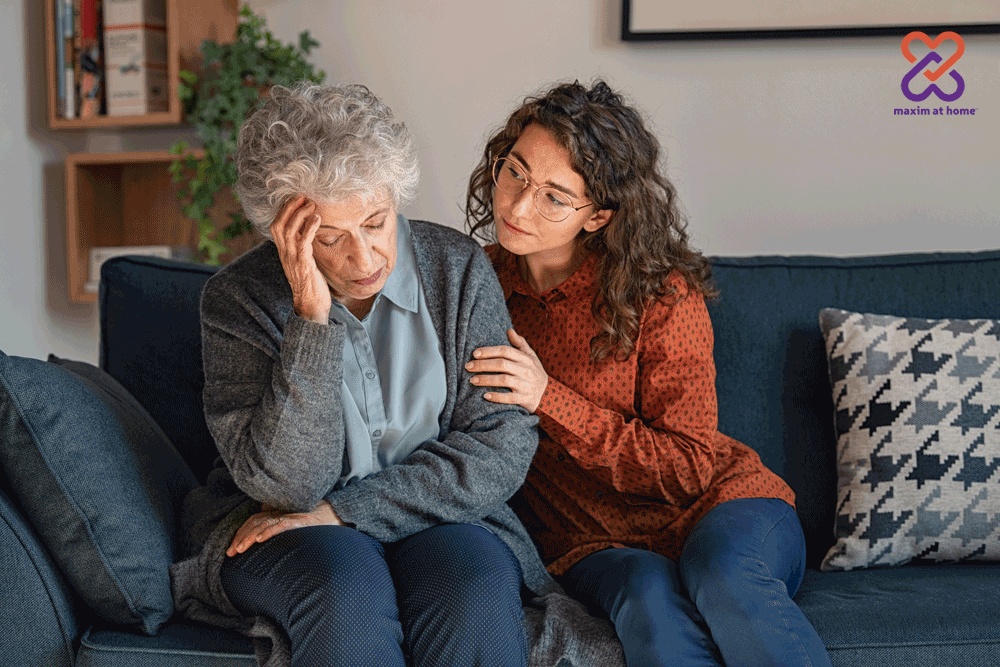Part 2 of 3: What Are Your Next Steps? Find the Right Doctor, Track Behavior & Ask the Right Questions
A “sundowner” is a term coined in 1987 by Lois K. Evans, a nurse who worked at a geriatric center where elderly with various stages of dementia and Alzheimer’s resided. Over time, she observed conditions that manifested primarily in the late afternoon and early evening, usually around sunset; hence, she referred to her patients as “sundowners”.
In Part 1 of the three part sundowner series: “Part 1 of 3: What is Sundowning, What Causes It, and How is it diagnosed” we discussed what “Sundowning is, possible causes and specific symptoms that people who have Alzheimer’s and dementia typically experience later in the day. According to the Alzheimer’s Association, its key identifiers are “problems sleeping or experiencing increased confusion, anxiety, agitation, pacing and disorientation beginning at dusk and continuing throughout the night.”
When someone in your life or your care is experiencing sundowning due to some form of Dementia or Alzheimer’s, it will affect how you approach the different ways to help them. You will also need to learn how to adjust your life to incorporate this new paradigm.
Part 2 – Recommended Steps
In this second part of our three-part series on Sundown Syndrome, entitled “Part 2: Finding the Right Doctor, Tracking Behavior & Asking the Right Questions”, we will discuss recommended steps to address the needs of a loved one who experiences sundowning. You will learn that there is a process you can follow to discover the scope of the underlying disease by finding the correct physician and following a process of information that will help physicians make informed decisions about your loved one’s condition.
As with anything medically oriented, if you suspect your loved one is experiencing Sundown Syndrome, please consult with their physician first to help you determine what steps need to be taken. Be sure to ask your loved one’s doctor about their own experience in diagnosing and treating dementia and sundowning so you know you have the right doctor for your issue.
Finding the Right Doctor
The first medical point of contact should always be your primary care physician. Typically, a skilled physician can diagnose Alzheimer’s, a core trait of sundowners, with 90% accuracy. If your loved one has had the same doctor for some time, the doctor will typically oversee the diagnostic process themselves. This should not stop you from asking them about their level of familiarity with diagnosing Alzheimer’s, dementia, or Sundowner Syndrome, as well as asking them what kind of circumstances would cause them to refer your loved one to a specialist.
It’s critical to understand that dementia is not a specific disease but a collective range of symptoms associated with memory and cognitive function. It can also be treated if caught in its early stages, so it is imperative that when you consult with a doctor, they have the proper training and experience to provide an accurate determination of the condition. The doctor will likely start by trying to determine what kind of dementia is fueling the Sundown Syndrome. The most common types of dementia are:
- Dementia with Lewy bodies: A disease associated with abnormal deposits of a protein called alpha-synuclein in the brain.
- Vascular dementia: Results from blocked blood flow to the brain, such as through a stroke, can reduce circulation and deprive your brain of vital oxygen and nutrients.
- Alzheimer’s disease: A brain disorder that slowly destroys memory, thinking skills, and eventually the ability to carry out even the simplest tasks.
- Frontotemporal dementia: Frontotemporal disorders (FTD), sometimes referred to as frontotemporal dementia, is caused by damage to neurons in the frontal and temporal lobes of the brain.
While many primary care physicians perform the initial assessment and evaluation, they may likely refer their patient to a specialist to confirm their initial diagnosis and help confirm the type of dementia present. Once that determination is made, a more informed plan can be implemented to address the sundowning behavior.

You May Need a Specialist
Multiple specialties focus on and diagnose various types of dementia. You should consult your physician about which specialist(s) will likely contribute. In some cases, the patient may be evaluated by two or more specialists, who will combine their findings to reach the most likely diagnosis. The types of physicians that may likely contribute their expertise are:
- Neuropsychologists: Tend to administer various tests to assess thinking abilities such as memory, attention, language, reading, and problem-solving.
- Neurologists: Trained in nervous system disorders, including issues with the brain, spinal cord, and peripheral nerves. They typically have formal training in dementia, Parkinson’s, and seizure disorders.
- Geriatric Psychiatrists: Trained in general psychiatry with a focus on mental health and aging, they typically provide great insight into how to deal with dementia-related behaviors.
The Evaluation Process
The doctor leading the evaluation process will likely order multiple tests to help evaluate the severity of the patient’s mental condition. This process may be broken up into multiple visits to allow time for the doctor(s) to fully evaluate and understand the findings of each test. The steps in the evaluation process may include the following:
- Past medical history: This includes current and past issues, conditions, and medications. Ensure that your doctor has access to all of your medical history records.
- Current exam: Standard procedure for any always includes taking blood pressure, temperature, pulse, etc., to help doctors rule out any physical issues.
- Depression screening: Typically conducted for people facing social isolation, this process includes answering a few specific questions that will add information regarding memory or cognitive function.
- Lab work: Blood and urine samples are routinely taken to help rule out various factors.
- Cognitive tests: These tests involve testing memory, problem-solving, and cognitive abilities to evaluate executive function, memory, and judgment.
- Brain imaging: The doctor may, in some cases, order a brain scan to look for possible brain tumors, past signs of stroke, aneurysms, or build-up of fluid in the brain.
These tests fall under the direct supervision of your medical doctor and specialists contributing to the diagnosis. The final piece of information to connect the dots regarding medical tests and their relation to everyday behavior must be sourced by someone who spends time with the person suffering from Sundowning Syndrome.
Tracking and recording of repetitive behavioral changes should be conducted by someone who ideally lives with the sundowner patient. The day-to-day can be recorded in a spreadsheet or journal.
Start a Behavior Journal
One of the best ways for you and your loved one’s doctor to understand the scope of the situation is to begin a behavior-tracking routine. Keeping a journal is an excellent way to track timing and patterns, or, if you’re digitally savvy, you can use a spreadsheet. Once you decide on how to record the behavior patterns that you’ll personally witness, make sure to keep them handy so that you can record the specific details while they are fresh in your mind.
It’s helpful to keep access to your tracking method (journal) handy throughout the day, whether it’s a physical journal or a laptop. When you have a challenging day with your loved one, and notice their behavior is a bit out of the norm, think about what they were doing before the behavioral change and what time of the day it was. Connecting behavioral patterns can be complex, so you need to pay attention to what might be the first signs of the change and what was occurring just before the change. Make sure to let the doctor or specialist know that you will keep a journal, so you can get direction from them regarding common symptoms to look for.
Commons Symptoms to Look For
The beginning stages of Sundowners Disease may be challenging to detect. These symptoms can be unpredictable and change from day to day. Prior knowledge of your loved one’s typical behavior can help you recognize any unfamiliar behavioral changes or patterns.

Here are some signs to look out for and examples of how to identify them:
Irritable: For instance, your loved one may be irritable about a topic or event that has never bothered them.
Suspicious/Paranoia: They may have misgivings about something they had never had a problem with before or suspect that a trusted friend might not be trustworthy for some strange reason.
Demanding: When you do things for them, they may suddenly have specific criteria on how it should be done or criticism on how it was done when they’ve never had a problem before. For example, if you prepare a dish just the way they always liked it and, for some reason, they can’t explain, they don’t like that method and want it done another way.
Sudden expression of emotion: They may suddenly start crying for no reason or withdraw because they feel depressed or upset about something.
Restlessness: During the sundown hours, when they might typically relax after dinner by watching a show, reading, or engaging in a hobby, they instead don’t know what to do with their time. They might pace around the house or look for something to do without being able to articulate what thing is.
Pacing, Wandering, or Rocking: If they usually do not exhibit these traits and you see them rocking in place, looking confused as they wander around, or pacing aimlessly, this could be a sign of distress.
Delusions or Hallucinations: When you have a conversation, you may notice that some of their tried-and-true stories have different endings, or they may talk about seeing something that is just not possible, like someone who has passed away or a person they’ve seen in a movie or show.
Shadowing: Shadowing occurs when the person closely follows and mimics the movements or mannerisms of their family members or companions.
These are just some of the many characteristics and traits that may manifest during sundowning, which commonly occurs during the evening hours. There is no way to predict what changes will occur, as it could be one or more of dozens of different variations. The one common factor is that they all occur between the late afternoon to just past twilight.
The best way to identify these changes is to keep track of them, and it cannot be stressed enough that you should remain in consultation with your loved one’s physician so that they can help you identify the traits to look for.
Keep an open mind towards another cause
It is important to note that a person may be presenting actions that, at first glance, seem to be related to sundowning; however, this may actually be a way for your loved one to communicate with you. As dementia progresses, speech/verbal communication can wane, so your loved one may be acting out to get your attention or the attention of your companion.
When it comes to identifying the triggers for these behavior changes, it is helpful to have a set of questions about these triggers handy so that you can be consistent in asking the same questions for each behavior event that occurs and evaluate each one evenly.
Asking the Right Questions
Figuring out what may or may not have triggered a sundown-driven behavioral change is challenging. You must evaluate each behavioral event separately but ask the same questions. If you have not done so already, speak to your loved ones’ physician, and let them know that you are going to track changes; ask them what aspects to look out for and how long you should track changes.
Information is key in helping the doctor help you. If you haven’t obtained a list of questions from a doctor, here are a few questions you can start with. It is recommended that you share this list with your loved one’s physicians, so they can ensure you are asking all the right questions for their assessment. Also, ask them how many days of tracked behavior they will need before you share the information with them.
When the change or trait manifests itself, grab your journal or notepad, and ask yourself the following questions. Write down the answers as best you can; remember, you’re going to share these with a physician, so be as detailed as possible:
- What behavioral event did you witness?
- Describe it in as much detail as possible.
- What time did the event happen?
- Have they recently had visitors?
- Was it family or friends who came to visit?
- Who was it, and why were they there?
- Did the behavior change during, after, or after the visit?
- Was there a change in noise level inside the house or outside?
- Was there any noisy landscaping, construction, or other noisy activity outside?
- Were the neighbors playing loud music?
- Was there a change in the noise of the house?
- Loud barking of a dog
- The stereo or movie playing loudly
- Were they late in taking their medication, or did they miss taking it entirely?
- Was there a significant change in their diet?
- Did they eat something new or something spicy?
- Is their bathroom routine off for any reason?
- Are they staying hydrated?
Save a Copy for Your Records
Once you have completed the doctor-recommended number of days tracking your loved one’s behavior, you may notice an eventual pattern emerging of “cause and effect” between various stimuli and non-stimuli in relation to erratic behavior patterns. This information is of great value to the loved one’s physicians and will provide critical insights to help them connect the dots regarding their professional assessment.
With your records completed, it is time to make a copy of everything you have recorded for each physician involved in your loved one’s care. Ensure they receive their copy and keep the original for your records. Ask them how long it will take for the team to review the information and return with a plan of action. Schedule a meeting with them after this date, and formulate an action plan to help your loved one’s quality of life and keep them safe.
Formulate an Action Plan
First, congratulate yourself. You’ve completed the challenging work and coordinated with your loved one’s medical team. You’ve accomplished more than most would ever attempt, and you can honestly tell yourself that you’ve done everything you can to get the most informed medical direction possible.
Now is the time to take a break and recharge while the doctors review data from their testing and compare it to your behavioral documentation. The next step will be speaking with them about the results of their findings and implementing an action plan.
We will cover that topic in Part 3 of our three-part Sundowner series.
Sundown Syndrome and the Elderly: Part 3 – What you can do at home
Part 3 of 3: Reducing Triggers, Coping Tips, and Strategies
“In this Part 3 of our three-part series on Sundown Syndrome: Action Plan After a Diagnosis – Reducing Triggers, Coping Tips, and Strategies – we will address available options. While there is no cure for Sundowners Syndrome, there are recommended options that are known to mitigate the condition. Hopefully, through information provided in this series, you can find a medically recommended combination that can help you keep your loved one in a position where they can continue to live in their home, where they feel safe and comfortable.”

The Maxim at Home team is here to help
Do you need help with a loved one? Then consider Maxim at Home’s homemaker and companionship services. Our team of friendly, compassionate Companions takes great pride in serving people in their own community who need light assistance with daily chores, some company and conversation, or convenient transportation for errands, appointments, or trips to the store.
Explore our services to learn more about our:
- Homemaker and companionship services
- Easy-to-use scheduling platform
- “Best Value” service pricing
- Only 1-hour service minimum
Sign-up in seconds to enjoy free 24hr access to our on-demand scheduling platform, where you can view our team of vetted compassionate companions.
If you have questions about our services, please feel free to call 1-844-624-5646 to speak to one of our caring service Advisors.
SUNDOWNER BLOG SERIES:
Part 1 of 3 – What you need to know • What is Sundowning, What Causes It, and How is it diagnosed?
Part 3 of 3: What You Can Do at Home • Household tips, Daily management, and At-home therapies
References:
Sleep Issues and Sundowning|
www.alz.org/help-support/caregiving/stages-behaviors/sleep-issues-sundowning
Coping with Sundowning
www.nia.nih.gov/health/tips-coping-sundowning
Older Adults and Dementia
www.alz.org/alzheimers-dementia/diagnosis/visiting-your-doctor
Living with Dementia
www.nia.nih.gov/health/alzheimers/living-with-dementia
Lewy Body Dementia
www.nia.nih.gov/health/what-lewy-body-dementia-causes-symptoms-and-treatments
Vascular Dementia
www.mayoclinic.org/diseases-conditions/vascular-dementia/symptoms-causes/syc-20378793
Alzheimer’s Disease
www.nia.nih.gov/health/what-alzheimers-disease
Frontotemporal Dementia
www.nia.nih.gov/health/what-are-frontotemporal-disorders
Sundown Syndrome
my.clevelandclinic.org/health/articles/22840-sundown-syndrome


